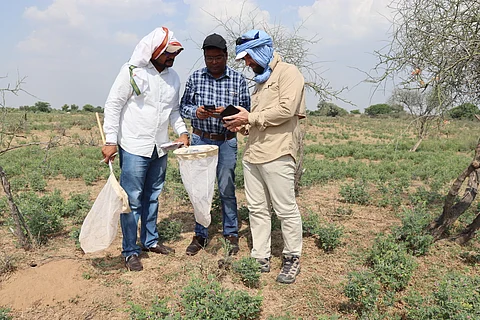
- Topics
- Feature
- Opportunities & Events
- About
- Hindi Portal
- Data
- Topics
- Feature
- Opportunities & Events
- About
- Hindi Portal
- Data

In the vast and arid regions of India, under the intense heat of the sun, a dedicated team of field officers responsible for surveying desert locust populations embarked on a mission. Accompanying them was a Locust Forecasting Officer from the Food and Agriculture Organization (FAO). Their objective was to meticulously assess the extent of desert locust presence across the districts of Jodhpur, Bikaner, and Jaisalmer. These areas are particularly susceptible to the devastating impact of locust swarms, which possess the remarkable ability to travel approximately 150 kilometers in a single day, leaving a trail of destruction in their wake by consuming crops.
While the current monsoon season witnessed a relatively low level of desert locust development in both India and Pakistan, it is of paramount importance to maintain vigilant surveillance during these periods of reduced activity. This proactive approach is crucial to ensure preparedness in the face of potential future swarms and to maintain a highly skilled and responsive human resource pool.
India has a history of grappling with locust incursions, with documented occurrences in both designated and non-designated desert areas in the years 1993, 1997, 2005, 2007, 2010, 2019, 2020, 2021, and 2023.
Over the course of seven days, the team diligently traversed a total distance of 2,570 kilometers, meticulously inspecting 30 distinct survey points. While some areas exhibited no signs of locust activity, isolated instances of immature, solitary adult locusts were observed in others.
The successful execution of this fieldwork was made possible through the collaborative efforts of the Directorate of Plant Protection, Quarantine and Storage, and the Regional Locust cum Integrated Pest Management Center (RLCIPMC) of India.
“The desert locust joint survey with FAO experts introduced many new tools, such as the PlantNet application, which helps in identifying desert weeds. This is useful for pinpointing hotspots in locust-prone areas. By exchanging information, utilising all available resources and equipment, and applying effective management techniques and practices, we were able to successfully control the locust outbreak,” said Virendra Kumar, Head of the RLCIPMC in Jodhpur.
Empowering a new generation of locust management experts
Prior to the commencement of fieldwork, Desert Locust Information Officers (DLIOs) and survey officers underwent comprehensive training in the fundamental utilization of advanced technological tools. These tools included the RAMSES v4.1 application, a sophisticated platform designed for data manipulation and analysis, as well as remote sensing imagery that provides valuable estimates of rainfall patterns.
The seamless integration of these cutting-edge technologies significantly enhances the capacity to effectively track locust movements and accurately predict their behavioral patterns, even before they reach critical population levels. This proactive approach empowers stakeholders to anticipate and respond to potential locust outbreaks more effectively.
“It was essential to train the officers in these tools since many are relatively new to their roles,” said Cyril Piou, FAO Locust Forecasting Officer, adding that “More training and experience will optimise their efficiency. FAO is committed to supporting them further in areas such as analysing locust situations, managing geospatial data, and integrating data into GIS.” The skills will also enable them to produce forecasts and regular national desert locust bulletins.
The training curriculum also encompassed comprehensive field-based guidance on effective survey methodologies and the strategic selection of survey stops. The officers were thoroughly introduced to the Food and Agriculture Organization's (FAO) meticulously defined standard operation procedures (SOPs) for ground surveys. These SOPs provide detailed guidelines on best practices for conducting comprehensive surveys within locust breeding areas. Notably, the recommended length for survey transects traversing various habitats was established at approximately 400 meters.
To ensure continuous capacity building within the Indian locust management framework, two dedicated locust officers will participate in an intensive one-month training program at the esteemed Desert Locust Information Service (DLIS) headquarters in Rome, Italy. This invaluable experience will provide India's leading locust experts with direct exposure to globally recognised best practices and the most recent advancements in the field of locust management.
To foster ongoing capacity development, two highly skilled locust officers will embark on an intensive one-month training program at the headquarters of the prestigious Desert Locust Information Service (DLIS) in Rome, Italy. This unique opportunity will provide India's foremost locust experts with invaluable exposure to globally recognised best practices and the most recent advancements in the field of locust management.
Enhancing survey efficiency
The survey findings definitively established that during periods of reduced locust activity, the breeding grounds of these insects are predominantly situated along the border regions of India where irrigation practices are not employed. In response to this observation, the team strongly recommended an increase in both the frequency and intensity of survey operations within these specific areas.
To enhance the effectiveness of future survey efforts, the team advised maintaining a consistent interval of five kilometers between survey points during cross-country expeditions. This strategic approach would facilitate more frequent access to potential breeding grounds and provide a more comprehensive understanding of locust breeding patterns during the monsoon season.
To optimise the utilisation of existing capabilities, the team proposed the implementation of joint survey missions involving both seasoned and newly appointed locust officers. This collaborative approach would serve to ensure the seamless transfer of valuable knowledge and maximise the effective utilisation of available expertise and resources.